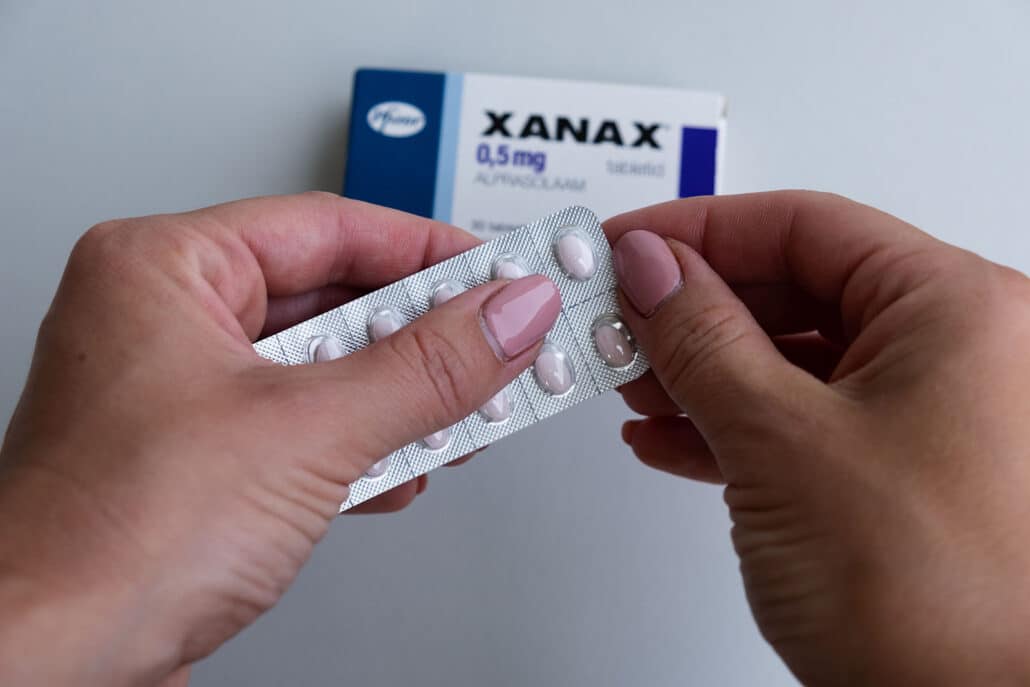Whether you are taking Xanax recreationally or as a prescription drug, this medication can lead to potential side effects. Unfortunately, all types of substance use can lead to unintended physical and mental effects. If you notice any unintentional or undesired symptoms, it’s important to reach out to your healthcare provider to get help right away.
Table of Contents
How Xanax Affects Your Skin and Face
Xanax is the brand name of a drug known as alprazolam, a type of benzodiazepine. While it is designed to treat anxiety disorders like panic disorder and generalized anxiety disorder, it can have unexpected side effects. This is especially true if you are using Xanax recreationally and taking higher doses than prescribed.
Once you are taking Xanax, you may experience dehydration. This can cause your skin to dry out, making your face look prematurely aged and wrinkled. Over time, Xanax can impact your skin’s production of collagen, worsening its elasticity and causing premature aging. Additionally, Xanax can lead to fluid retention, making your face appear swollen and puffy.

Many people feel sedated when they take Xanax, and sleepiness and sleep disturbances are fairly common side effects. Because of these factors, you may look more tired or develop dark circles under your eyes.
Indirect Effects of Xanax Use on Facial Appearance
While Xanax can directly impact your facial appearance, it can also indirectly change how you look. Many recreational users start using Xanax for its calming and sedating effects. However, these same effects may cause them to neglect self-care. Neglecting skincare, showers, and other grooming habits can negatively affect appearance.
Similarly, people may not feel as motivated to eat a proper diet when they feel sedated all the time. Unfortunately, a lack of nutrients can impact skin health. Your body needs a healthy balance of vitamins to create collagen and build supple skin.
Finally, some recreational users may develop stress and anxiety-related habits that can harm their appearance. For instance, clenching the teeth and frowning can negatively impact how you look.

What Are the Side Effects of Xanax?
Besides affecting your face and skin, Xanax can carry other unwanted common side effects. It’s important to never use this drug for off-label or recreational purposes. The following are some of the mild side effects associated with Xanax use:
- Dry mouth
- Dermatitis and skin allergies
- Fatigue
- Drowsiness (sedation)
- Balance and coordination issues
- Memory loss
- Low blood pressure
- Irritability
- Dizziness or feeling lightheaded
- Confusion
- Rage and aggressive behavior
- Increased saliva production
- Confusion
- Low energy levels
- Low Sex Drive
- Appetite changes
- Problems sitting still
- Weight changes (weight gain or weight loss)
- Skin rashes
- Constipation
- Speech issues
If you experience any of these side effects, it is important to talk to your doctor or pharmacist. Many of these symptoms can be alleviated or managed if caught and treated early.
Sometimes, Xanax can cause more serious side effects. If you notice any of the following issues, you should get medical attention right away. Some symptoms can be potentially life-threatening, so seeking professional medical care is essential if you undergo any serious symptoms.
- Hallucinations
- Severe allergic reactions
- Liver issues (possible liver disease)
- Seizures
- Breathing problems (trouble breathing)
Opioids can slow your breathing and lead to respiratory depression. This effect is worsened if you take opioids and Xanax at the same time. As a result, you should never use these medications together.
When used over an extended period, Xanax can lead to physical dependence. If you believe you have an addiction to Xanax, professional treatment centers can help you manage withdrawal symptoms as you discontinue using the drug.

Ways To Improve Your Skin Health During Recovery
Once someone stops using drugs, they have more time to care for their physical and mental health. Substance use disorders can negatively impact skin health. As you begin recovery, replace bad habits with healthy self-care activities that nourish your skin and support overall well-being.
While various substances are known for causing specific problems, the following are general skin complaints that people commonly develop due to substance use disorders:
- Acne
- Premature wrinkles
- Broken capillaries on the face
- Inflamed, swollen palms
- Red skin on the nose and cheeks
- Frequent skin infections, rashes, and sores
Fortunately, the following skincare tips can help you alleviate premature wrinkles, acne, rashes, and similar problems.
Boost Your Hydration
One of the most important things you can do for your skin is to stay hydrated. Dehydration is fairly common during detox, so make sure to drink more water.
Improve Your Nutrition
Now that you have started your recovery, you will have more time. Use this time to shop for healthy fruits, vegetables, and lean meats. Then, learn ways to prepare these food items to enjoy a balanced diet. By ensuring you get the right blend of vitamins and minerals, you can improve the quality of your skin.
To support your skin’s beauty and health, ensure your diet has plenty of vitamins B, C, and D. Zinc and magnesium are also incredibly effective for healing the skin. Fish and other sources of fatty acids can plump up your skin and give it a healthier appearance.
Cleanse, Moisturize, and Tone Your Skin
Often, people skip their skincare routine when actively using drugs. Once they start the recovery process, devoting time to self-care routines is easier. You can talk to a skincare specialist about the best options for your skin. For example, you may want to use a toner, cleanser, and moisturizer each morning and evening. If you suffer from dry lips, a nighttime lip mask can help moisturize this delicate area.
Address the Root Cause of Your Substance Abuse
During recovery, one of the most important things you can do is treat the root cause of your addiction. For example, someone may develop a Xanax addiction because they took Xanax to relax in social situations. To avoid relapse, they must learn healthier ways to overcome social anxiety.
Similarly, many people turn to opioids to manage chronic pain. During rehab, an addiction specialist can work with you to figure out your co-occurring disorders. By treating the root cause of your addiction and learning to manage potential triggers, you can prevent a relapse.

How Long Island Interventions Can Help
At Long Island Interventions, you can get professional help with Xanax dependency and misuse. This treatment center offers holistic support for all of your emotional, physical, and mental needs. During the initial stage of your treatment, an addiction specialist will perform a complex evaluation of all your co-occurring disorders. Then, they will tailor a customized treatment plan designed to match your individual needs.
For many people, the initial withdrawal process can be incredibly overwhelming. At Long Island Interventions, you can receive medical support and supervision during the detox process. Besides preventing severe withdrawal symptoms, medical support can help you alleviate your symptoms so you can move on to the next stage in your recovery.
To provide you with the best level of support, we offer inpatient and outpatient treatment options. With an inpatient program, you can get intensive, around-the-clock care. Because you are under constant supervision, it is impossible to relapse until you have completed your rehab stay. Meanwhile, outpatient programs are a popular choice among people who still have to manage work responsibilities and family obligations as they complete their course of treatment.
Get Assistance With Your Recovery Journey
If you are struggling with Xanax misuse, you don’t have to become sober on your own. Long Island Interventions has years of experience in treating substance use disorders. To get started on your recovery, reach out to one of our experienced addiction specialists today.
Published on: 2024-12-31
Updated on: 2025-05-15

